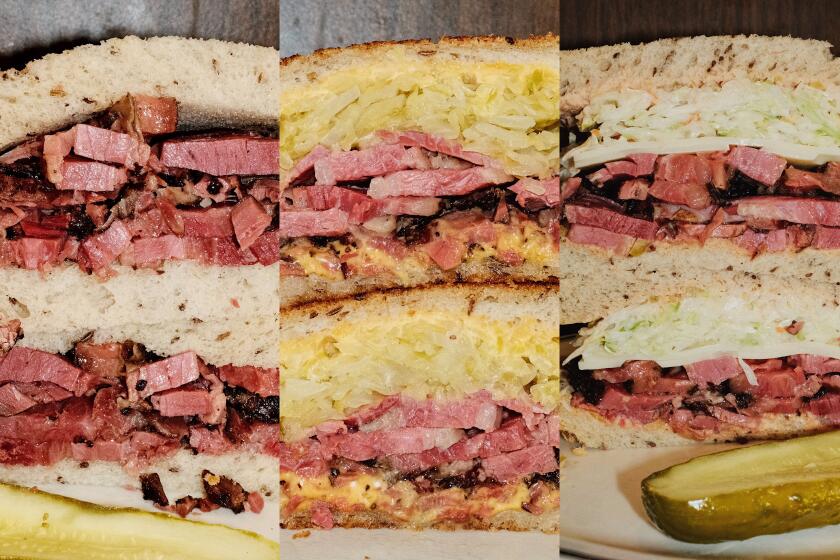Market Watch: Moro blood oranges at the legal limit of ripe in Ventura County
Moro blood oranges grown in Southern California are almost different fruits from those grown in the San Joaquin Valley, the state’s leading citrus district. They’re smaller in size, lighter in color and a month or more later in ripening. By April, San Joaquin Valley Moros often develop musty off-flavors, but when grown in Southern California the variety can remain in good condition well into the spring and arguably develops its sweetest, richest flavor here.
The season is particularly late at Old Gold Farms, which grows 6 acres of Moros in Somis, a relatively cool area of Ventura County. It just started harvest a few weeks ago; the fruit is still a little tart for most palates and will reach peak quality in June and July.
Nestled in a chaparral-rimmed valley a few miles north of California Highway 118 in Somis, it’s an odd farm in several ways, as became clear on a recent visit. Blood oranges are its only crop, and blood orange juice is its specialty. The grove serves as recreation and landscaping for the owner, lawyer Howard Gold, and his wife, Amy. And it’s likely one of the few farms in California in which outdated legal files, carefully shredded, are used as mulch.
Howard Gold, now 62, discovered blood oranges 20 years ago at Brandywine restaurant in Woodland Hills. He and his wife had just bought a 22-acre property in Solano Verde Ranches and were considering how to landscape it. As an alternative to a lawn, he decided to plant a blood orange grove, grafted by an 85-year-old man at a nearby nursery. He called the venture Old Gold Farms from his name, and as a whimsical allusion to the old-fashioned cigarette brand.
Gold continued planting each year for a decade, until he had 1,300 trees, or 13 acres, although half of these were destroyed in a 2003 fire. The trees, which received lots of love but minimal professional care, took their own sweet time to bear fruits, so for many years the Golds mainly gave away the small crops to family and friends, or consumed the harvest themselves. But around 2004, as the trees matured and started bearing more heavily, the Golds began selling at the Camarillo farmers market on Saturdays.
“The first time it took us like an hour to set up the tent, and everyone was looking at us like, ‘What planet are they from?’ ” says Amy.
It was a tough slog at first, explaining blood oranges to local customers, some of whom thought the red flesh meant the fruits were spoiled while others thought the name “blood orange” was creepy.
“We couldn’t sell them, and they were starting to soften,” says Howard. “I just couldn’t see throwing them out, so I tried making juice, and people really liked it.”
The Golds squeeze the ruddy juice at a commercial kitchen in Santa Paula and sell it in elegant clear glass bottles, making it look like red wine. The bottles carry a $1 deposit, but the Golds also offer plastic containers.
Recently Howard promoted his 16-year-old son, Gabe, who has helped out with the farm for a decade, to general manager of Old Gold, and Gabe does most of the work selling at farmers markets, along with a buddy, Luke Maple. Currently they just sell at the Camarillo farmers market, but they plan to expand in a few weeks to sell at the Malibu (Sunday) and Moorpark (Friday) venues.
Amy, who was born in Canarsie neighborhood of Brooklyn, N.Y., and ran a knish bakery with her sister for many years, makes an excellent blood orange marmalade, which is sold at the market. She is developing a blood orange sorbet and plans on offering blood orange products online.
Even as the Gold family expands production and marketing from their grove, it is clear that its main reason for being is the joy that it brings them.
“It is a delightful fantasy come true,” says Howard. “Some people come home and drink vodka – I walk my orchard.”
***
Tip of the week: Tahitian pummelos have much thinner skin and juicier flesh than other varieties and an alluring lemon-lime, sweet-tart flavor. Perhaps they’re neglected because they’re typically so seedy that you practically need a hacksaw to cut them in half, but the flavor is far more intense and interesting than that of other pummelos grown here.
Fillet Tahitian pummelos by cutting them into sections and peeling off the bitter membranes, or juice them and use for sorbet, or a “Tahitian pamplemousse margarita.” Mud Creek Ranch has just a few trees in Santa Paula and sells the fruits at the Santa Monica (Wednesday) and Hollywood (Sunday) markets. Other growers are starting to catch on and plant this delicious and distinctive, but far too little-known, citrus.
More to Read
Eat your way across L.A.
Get our weekly Tasting Notes newsletter for reviews, news and more.
You may occasionally receive promotional content from the Los Angeles Times.










